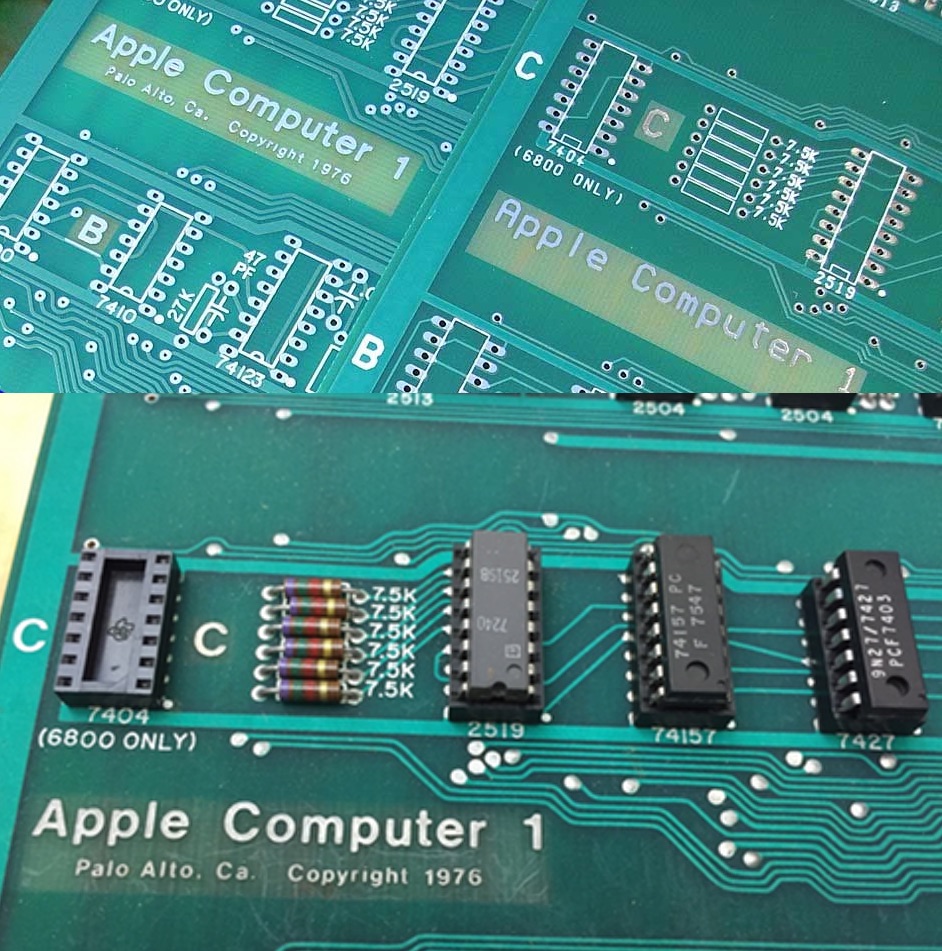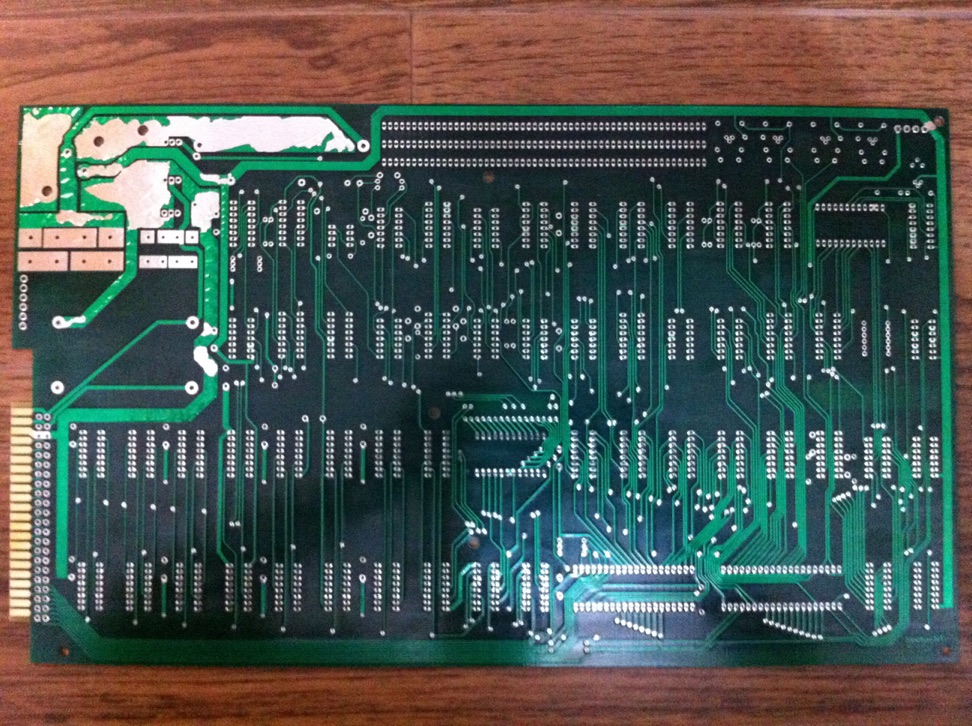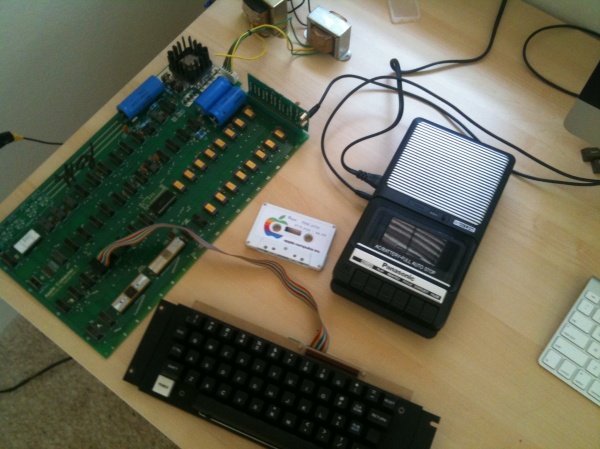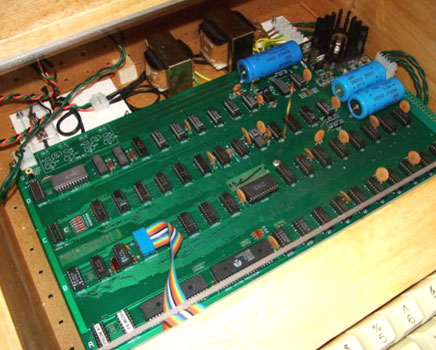Apple-1 Reproductions
The idea of an accurate Apple-1 reproduction was introduced by Steve Gabaly who also produced Mark-8 reproduction PCBs. Steve Gabaly had access to an original Apple-1 but did not have permission from Steve Wozniak directly to create his reproduction so the Obtronix is easily identified becuase it does not have a copyright underneath the Apple-1 logo. The Apple-1 was never actually copyrighted and is technically opensource since Steve Wozniak gave the design out at the home brew computer club.
The Apple-1 PCB layout was done in 1976 by Howard Cantin using tape which was stretched to make turns in the traces. Steve Gabaly used modern digital layout software which made hard angle changes for the traces and lettering.
Below is a picture of an early Mimeo and Obtronix board compared to an original board.

Steve no longer makes the Obtronix, so it is the rarest of reproductions. This is actually the main reason Mike Willegal set out to create the Mimeo. He was unable to purchase an Obtronix Apple-1.
The next realistic reproduction was Mike Willegal’s Mimeo Apple-1. Mike prefected his PCB layout techniques creating a replacement Rev-0 Apple ][ board for his early Apple ][ that he purchased in 1978. This Apple ][ has been updated and repaired over the years and no longer had the original PCB. Mike decided to create his own using high resolution photographs on the internet. Unlike the Apple-1, the Apple ][ PCB was digitally layed out, so he was able to come very close to the original (I have an original Rev-0 Apple ][ and one of Mike’s reproduction boards). Mike spent a lot of time overlaying the traces and the photograph to match the layout of the original. He brought this same attitude to the Mimeo when recreating the Apple-1, however he needed to manually manipulate the traces to match the curves the Apple-1 has, fighting along the way with the PCB software that wants to make angular traces. Mike also had to manually recreate the fonts used for the silk screen. A few years later Mike noticed the lettering matched the lettering in older comic books which were the Leroy font. He has since done some updating to the Mimeo for even more accuracy thanks the his relationships with actual Apple-1 owners providing detailed measurements and photographs. These changes include updates to the mounting holes, green coat finish and silkscreen. Since creating the Mimeo, it has become the most popular and consistently the most accurate reproductions of the Apple-1. A movement has started of people looking to find the exact parts and build up the Apple-1 reproductions as accurately as possible. I’d like to take credit for this when I build my second Mimeo and traked down the exact part number for the sockets, which was complicated by the fact the part changed but the number didn’t, however Cameron Cooper really started the craze. He didn’t at first the most accurate sockets, but he scavanged date correct and package parts for one of the first Mimeo PCBs to ever be built.
Next came the Newton-1. Mike Ng (Netwon) in Hong Kong who works in the PCB maufacturing business decided to create his own Apple-1 reproduction.
Mike Ng brought a unique approach, while he used the same hi-resolution photograph from the internet Mike Willegal used for the Mimeo, Mike Ng with his connections in the PCB industry in China had the ability to try out different manufacturing techniques to replicate the way boards were created back in 1976. Most of these failed as you can see in the photograph below, and in the end he has reverted back to the creating PCBs in the normal way.

Early Newton boards had very modern looking silkscreen fonts, later Mike Ng updated the Newton-1 to use the Leroy font set that Mike Willegal discovered was used by Howard Canton when creating the Apple-1 layout. The Newton-1 still is missing some of the corrections the Mimeo has, but Mike Ng does not have access to original Apple-1 units, so this in an incredible job from a set of photographs.
The Newton is also unique in that it does have both ByteShop versions and NTI versions of the Apple-1. No one else has an NTI reproduction PCB available.
I have seen other reproduction PCBs that have come out of Russia and Asia, but they seem to be much less accurate than the Newton or Mimeo.

You can contact me at corey@myapplecomputer.net
www.myapplecomputer.net


